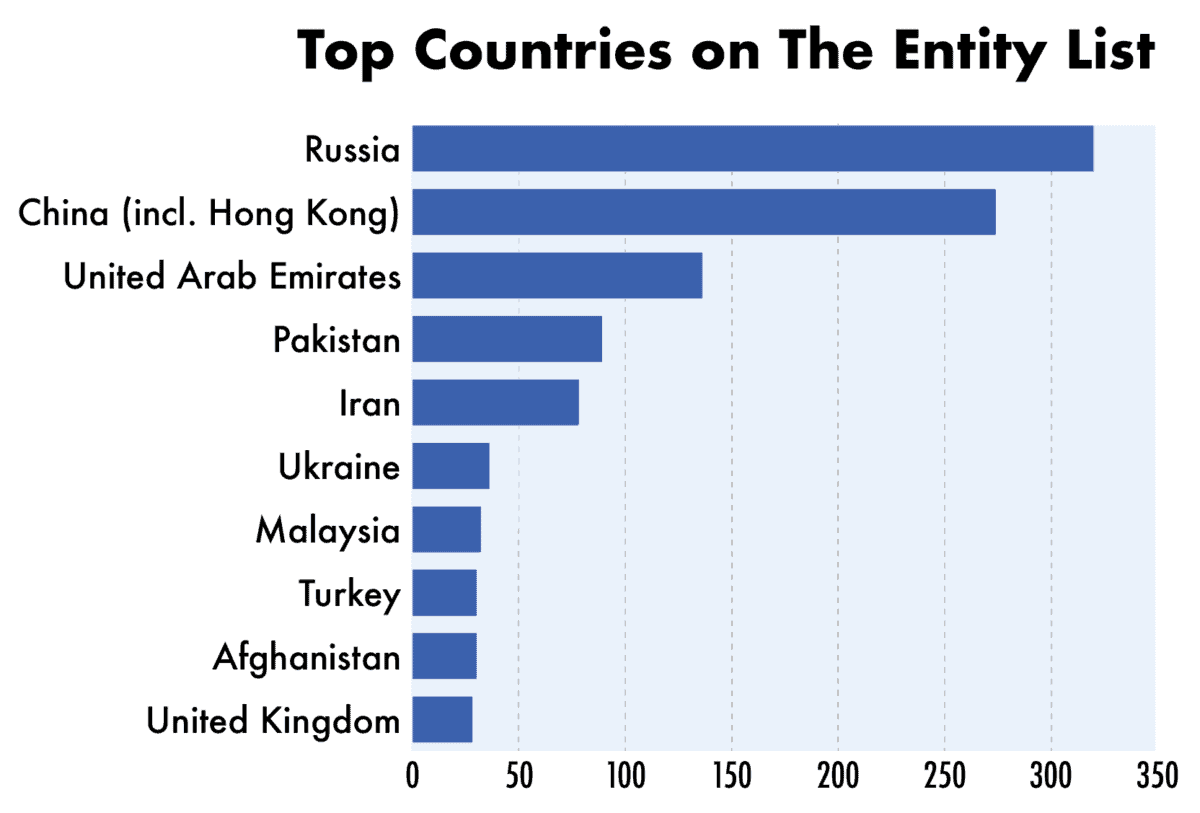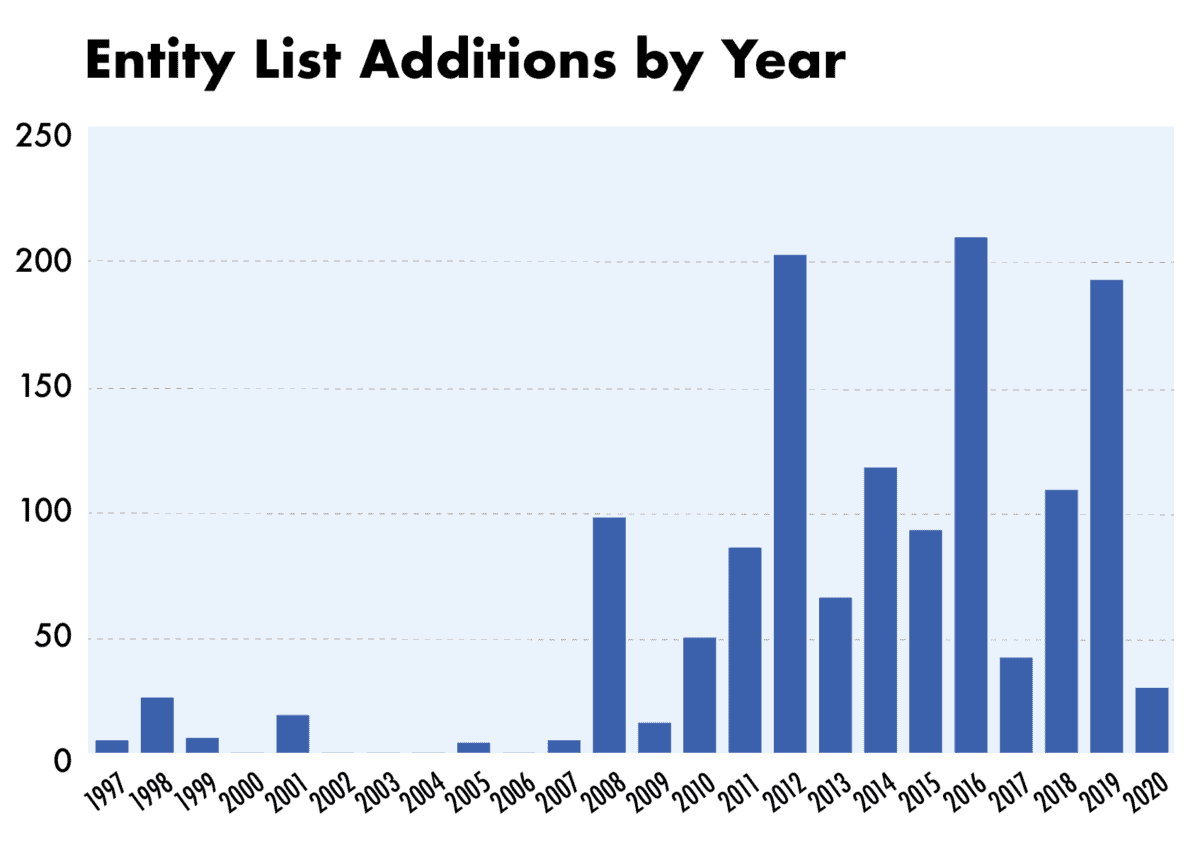
Credit: Lutsenko_Oleksandr, Shutterstock
In recent years, the U.S. has added a growing number of Chinese companies, including some leading tech companies, to the U.S. Entity List, which makes it harder for those companies to do business with Americans. The list has been an ongoing source of tension in U.S.-China relations, and this month, China’s state-backed Global Times reported that China “is ready to take a series of countermeasures,” including adding American companies such as Apple, Boeing, and Cisco to its own list — an “unreliable entity list.”
It remains to be seen what, exactly, that means, but in this week’s Big Picture, we explain how the American Entity List started, why it matters to U.S.-China relations, and introduce some of the key Chinese companies on the list.
Background

Data: Code of Federal Regulations (15 C.F.R. Part 744)
The Entity List was created in 1997 and was initially intended to address the risk of U.S. exports being diverted for use in weapons of mass destruction (WMDs). The list is maintained by the U.S. Department of Commerce’s Bureau of Industry and Security (BIS), and today it restricts exports, especially of sensitive commodities and technologies, to foreign entities that may use them in ways that harm U.S. national security.
William A. Reinsch, an international business and trade expert at CSIS, told The Wire that the list is seen as a “useful policy tool” because it allows the government to act with “surgical precision.”

Data: Code of Federal Regulations (15 C.F.R. Part 744)
The current list consists of close to 1,300 entities.1Some entities on the list are different branches or subsidiaries of the same parent, so 1,300 is an overestimate of the number of different people or companies represented. “Entities” can be people or organizations — companies, research institutes, government organizations, etc. Almost half of these entities are located in Russia or China (including Hong Kong),2Addresses themselves do not fully represent the nationality of entities on the list. For example, while the majority of Huawei entities on the list are in China, some are Huawei’s outposts in other countries, from France to Chile. and the majority of the entities on the list today were added in the last ten years.
The Entity List is not the only blacklist in town, however. The U.S. Departments of Commerce, State and Treasury keep multiple lists of sanctions evaders, arms traffickers and red-flagged people and companies. U.S. businesses are responsible for checking these lists, and multiple software programs exist to aid compliance.
China Trends
Chinese entities have been on the list since its early days, but recent years have seen a surge in Chinese additions as well as some very high profile cases.
Chinese telecoms equipment firm ZTE, for instance, was added in 2016 for exporting controlled items to Iran and North Korea. A year later, the company pleaded guilty and agreed to pay more than $1 billion in penalties to several U.S. government agencies, and it was removed from the Entity List.
Perhaps most famously, telecoms giant Huawei was added to the Entity List in May 2019 for violating Iran sanctions. More than 100 Huawei-related entities have been added to the list in the past year, and in the past few weeks, the Commerce Department has tightened its crackdown on Huawei with a rule intended to close loopholes that allowed the company to buy chips made outside the U.S. but that still use U.S. software and technology.
On Oct. 9, 2019, the U.S. added 28 entities that are implicated in human rights violations against Uighurs in Xinjiang. These additions were the first time the Entity List was used for human rights violations, according to CSIS, and many of the entities, such as SenseTime (the subject of this week’s cover story) and Megvii, are artificial intelligence firms whose facial and voice recognition and other technologies are used by the Chinese government for mass surveillance.
Most recently, on May 22, the Commerce Department announced plans to add 33 more Chinese entities to the list, some for military ties and some for Xinjiang human rights abuses.

China Companies on the List
Most entities on the list fall under a “presumption of denial” license policy, which means that BIS is likely to deny licenses to export to those entities. This policy technically leaves room for BIS to exercise discretion in approving or denying licenses, but the uncertainty alone acts as a deterrent.
Aside from Entity List applications, Reinsch said that, though he hasn’t seen recent data, BIS’s approval rate is relatively high because most applications are for items that BIS does not perceive as a threat or are going to acceptable destinations. “Exporters avoid applications expected to be losers,” he said.
Like what you’re reading? Subscribe today for more in-depth, data-driven storytelling and expert analysis.
Interestingly, Microsoft was among the American tech companies granted a license recently to do business with Huawei, reportedly to sell mass-market software.
Steve Dickinson, an attorney at Harris Bricken, told The Wire that many in the tech industry believe that the recent Entity List rules are set up to benefit larger multinational companies. “The expense, delay and uncertainty cannot reasonably be borne by [small and medium sized companies],” he wrote, and multinationals may be able to “obtain favorable treatment that is not available to smaller companies.”


Emma Bingham is a Boston-based editor for The Wire. Previously, she was editor in chief of The Tech at the Massachusetts Institute of Technology. @emmapbingham

Kara Greenberg is an editor at The Wire. @karagreenberg_



